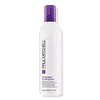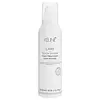What's inside
What's inside
 Key Ingredients
Key Ingredients

No key ingredients
 Benefits
Benefits

No benefits
 Concerns
Concerns

 Ingredients Side-by-side
Ingredients Side-by-side

Water
Skin ConditioningIsobutane
Vp/Va Copolymer
Hedychium Coronarium Root Extract
MaskingPEG-12 Dimethicone
Skin ConditioningBisamino PEG/PPG-41/3 Aminoethyl Pg-Propyl Dimethicone
Steareth-21
CleansingPolyquaternium-11
Cocamidopropyl Betaine
CleansingCocamidopropyl Hydroxysultaine
CleansingDiazolidinyl Urea
PreservativePPG-5-Ceteth-20
EmulsifyingCaprylyl Glycol
EmollientPhenoxyethanol
PreservativePentaerythrityl Tetracaprylate/Tetracaprate
EmollientPropane
Sodium Chloride
MaskingLaurtrimonium Chloride
EmulsifyingSodium Bisulfite
AntioxidantParfum
MaskingHexyl Cinnamal
PerfumingHydroxycitronellal
PerfumingLimonene
PerfumingWater, Isobutane, Vp/Va Copolymer, Hedychium Coronarium Root Extract, PEG-12 Dimethicone, Bisamino PEG/PPG-41/3 Aminoethyl Pg-Propyl Dimethicone, Steareth-21, Polyquaternium-11, Cocamidopropyl Betaine, Cocamidopropyl Hydroxysultaine, Diazolidinyl Urea, PPG-5-Ceteth-20, Caprylyl Glycol, Phenoxyethanol, Pentaerythrityl Tetracaprylate/Tetracaprate, Propane, Sodium Chloride, Laurtrimonium Chloride, Sodium Bisulfite, Parfum, Hexyl Cinnamal, Hydroxycitronellal, Limonene
Water
Skin ConditioningIsobutane
Vp/Va Copolymer
Propane
Polyquaternium-11
Butane
PEG-12 Dimethicone
Skin ConditioningPhenoxyethanol
PreservativeTrideceth-9
EmulsifyingPanthenol
Skin ConditioningParfum
MaskingArginine
MaskingGlucose
HumectantPEG-40 Hydrogenated Castor Oil
EmulsifyingPEG-5 Ethylhexanoate
EmulsifyingButylene Glycol
HumectantCitric Acid
BufferingAcid Violet 43
Ethylhexylglycerin
Skin ConditioningHelianthus Annuus Seed Extract
Skin ConditioningWater, Isobutane, Vp/Va Copolymer, Propane, Polyquaternium-11, Butane, PEG-12 Dimethicone, Phenoxyethanol, Trideceth-9, Panthenol, Parfum, Arginine, Glucose, PEG-40 Hydrogenated Castor Oil, PEG-5 Ethylhexanoate, Butylene Glycol, Citric Acid, Acid Violet 43, Ethylhexylglycerin, Helianthus Annuus Seed Extract
Ingredients Explained
These ingredients are found in both products.
Ingredients higher up in an ingredient list are typically present in a larger amount.
We don't have a description for Isobutane yet.
Parfum is a catch-all term for an ingredient or more that is used to give a scent to products.
Also called "fragrance", this ingredient can be a blend of hundreds of chemicals or plant oils. This means every product with "fragrance" or "parfum" in the ingredients list is a different mixture.
For instance, Habanolide is a proprietary trade name for a specific aroma chemical. When used as a fragrance ingredient in cosmetics, most aroma chemicals fall under the broad labeling category of “FRAGRANCE” or “PARFUM” according to EU and US regulations.
The term 'parfum' or 'fragrance' is not regulated in many countries. In many cases, it is up to the brand to define this term.
For instance, many brands choose to label themselves as "fragrance-free" because they are not using synthetic fragrances. However, their products may still contain ingredients such as essential oils that are considered a fragrance by INCI standards.
One example is Calendula flower extract. Calendula is an essential oil that still imparts a scent or 'fragrance'.
Depending on the blend, the ingredients in the mixture can cause allergies and sensitivities on the skin. Some ingredients that are known EU allergens include linalool and citronellol.
Parfum can also be used to mask or cover an unpleasant scent.
The bottom line is: not all fragrances/parfum/ingredients are created equally. If you are worried about fragrances, we recommend taking a closer look at an ingredient. And of course, we always recommend speaking with a professional.
Learn more about ParfumPEG-12 Dimethicone is a type of water-soluble silicone. It has skin conditioning and hydrating properties.
According to a manufacturer, this ingredient's stability is decreased by strong acid or alkali.
Phenoxyethanol is a preservative that has germicide, antimicrobial, and aromatic properties. Studies show that phenoxyethanol can prevent microbial growth. By itself, it has a scent that is similar to that of a rose.
It's often used in formulations along with Caprylyl Glycol to preserve the shelf life of products.
We don't have a description for Polyquaternium-11 yet.
Propane is a gas derived from petroleum and natural gas. It is used as a propellant.
This ingredient is most commonly used in shaving cream, hair products, and makeup.
We don't have a description for Vp/Va Copolymer yet.
Water. It's the most common cosmetic ingredient of all. You'll usually see it at the top of ingredient lists, meaning that it makes up the largest part of the product.
So why is it so popular? Water most often acts as a solvent - this means that it helps dissolve other ingredients into the formulation.
You'll also recognize water as that liquid we all need to stay alive. If you see this, drink a glass of water. Stay hydrated!
Learn more about Water